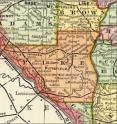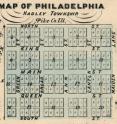At great expense, railroad bypassed first black-founded town in the US
Related images
(click to enlarge)
Ignoring topography, efficiency, expense and even their own surveyors' recommendations, regional railroad officials in the mid-19th century diverted a new rail line around New Philadelphia, Ill., "the first town in the United States planned, platted and legally registered by an African American," a University of Illinois researcher reports. The bypass pushed what would have been a fairly straight, even run of railroad tracks from Griggsville, Ill. to Hannibal, Mo., in a wide, hilly arc around New Philadelphia. The findings, reported in Historical Archaeology, are the result of an exhaustive review of railroad company records, maps, government orders, land deeds, surveys, engineering reports and newspaper accounts from the period.
Founded in 1836, New Philadelphia began as an audacious experiment that tested the limits of racial tolerance in a country divided by slavery. Decades before the Civil War, black and white families lived and worked together in New Philadelphia. Frank McWorter, a Kentucky slave who had managed to buy his wife's freedom and then his own in the early 1800s, bartered for land in Illinois and later expanded his holdings to build the town. Over the years, McWorter rescued several other slaves, bringing them north to Illinois.
The 42-acre town was advantageously situated on a busy east-west wagon road, about half way between the Illinois and Mississippi rivers in Pike County in western Illinois. Farmers carrying produce or driving cattle to one or the other river for transit to market would use the road, which ran along the northern edge of town.
"Much of the growth of New Philadelphia was probably fueled by that wagon-based traffic going on that road," said University of Illinois anthropology professor and archaeologist Chris Fennell, who led the study. "We see a whole host of merchants, blacksmiths, carpenters, a wheelwright and a wainwright (wagon builder) take up residence in the town."
At its peak, recorded in the 1865 state census, the town had about 160 residents. After the new rail line was completed, bypassing the town in 1870, New Philadelphia began to lose residents. In 1885, much of the town reverted to farmland; by the 1890s the town was defunct.
Fennell said he, his students and colleagues explored every hypothesis that could plausibly explain why the Pike County Railroad Company (PCRC, later called the Hannibal Naples Railway Company) chose to divert the rail line off an otherwise straight run between Griggsville and Hannibal.
The company paid for a survey of the proposed rail line in 1857, and the surveyors recommended that the railroad run in a straight, east-west line across most of Pike County. This new line would connect the vast eastern railway system that included the Illinois Central Railroad to the western regional railroad, which at that time went no further east than the Mississippi River. A fairly straight path between Naples, Ill., where the Central Railroad had a depot, and Hannibal, Mo., would have taken the rail line through New Philadelphia.
That path also would have conserved the most expensive component of the new rail system: its iron rails. The Toledo Wabash Railroad Company, which was to run and maintain the railroad, insisted that the builders use only the highest-grade iron rails, Fennell said.
"They had to use English iron to do this because the American foundries couldn't produce the volume and consistency of iron needed," he said.
But the PCRC holding company asked the surveyors to modify their proposed route, bending the rail line north around the headwaters of Keyser Creek, which ran alongside New Philadelphia.
"There are many reasons that a particular railroad route might take one path rather than another," Fennell wrote. "If a topographic feature such as a high point of elevation or a deep ravine lies along a particular path, a railroad will often be diverted to avoid the expense of traversing that location."
But Keyser Creek was shallow, and a review of decades of newspaper clippings from the area found no reports of it ever flooding, Fennell said. A landscape analysis revealed that the topography of the area actually favored the original route.
"The northernmost part (of the rail line's loop around Keyser Creek) is 150 feet higher than all the rest of the length of this railroad," Fennell said.
The change in elevation was so abrupt that, once the railroad was built, the Toledo Wabash Railroad Company had to station a "helper locomotive" at Hannibal to "pull the freighter past the high point on the northern part of that arc," Fennell said. (This led many to call for the railroad company to rebuild that part of the line further south, as the surveyors had originally proposed.)
The cost of building a culvert over the shallow creek could not compare to the expense of the added iron rail, Fennell said.
"You actually are having an increase in iron not only for the curve in horizontal space but also because you're going up in elevation and down in elevation," he said.
Neither political nor economic pressure from people along the route was a factor either, Fennell found. There were no towns north of New Philadelphia between New Salem, where the bypass began, and Barry, where the rail line straightened out again. No wealthy or influential landowners to the north of New Philadelphia lobbied for the route change or contributed to the PCRC.
In fact, PCRC officials were so committed to their otherwise straight path across Pike County that, despite active lobbying by county officials, they refused to move the line further south to connect to the county seat, Pittsfield. Instead, they built a spur to connect Pittsfield to the main line.
"The last explanation standing," Fennell said, is that PCRC officials, who were based in Hannibal, a slave-market town, "did not want to see New Philadelphia thrive as a depot town."
"This is an instance where racial ideology leads to a net loss for everyone," Fennell said.
Source: University of Illinois at Urbana-Champaign
Other sources
- At great expense, railroad bypassed first black-founded town in the United Statesfrom Science DailyMon, 1 Nov 2010, 18:30:28 UTC
- At great expense, railroad bypassed first black-founded town in the USfrom Science BlogMon, 1 Nov 2010, 17:30:23 UTC
- At great expense, railroad bypassed first black-founded town in the USfrom PhysorgMon, 1 Nov 2010, 16:01:27 UTC


